Subjects
All
Search
Archives
Latest
Latest News

Time to say Goodbye
Posted in General on Sunday 29th December 2019 at 5:07pm
Our ten-year commitment to the Higher Level Stewardship Scheme with Natural England ends on 31st December 2019. The scheme funded free walks for interested groups to visit the farm and hydro-electric scheme. Since the beginning of 2010 we have had 152 visiting groups totalling over 2400 visitors including schools, colleges and universities, history groups and U3A, many different societies and the School for the Blind GCSE students. Although most of the activity has been providing walks at Old Walls the other part of Waterleat Walks and Talks has involved us visiting village halls and educational establishments to put on power-point presentations about the planning and building of the Old Walls hydro scheme. We also provided virtual walks for the less mobile folk that were interested in what we did. We have met some fascinating people and the learning experience has always been 2-way.
We are now at the end of December 2019 when Waterleat Walks and Talks will conclude. Thank you to all who came to visit us, we have thoroughly enjoyed sharing our business and home with you. Time to put the story boards away for the last time. Farewell.
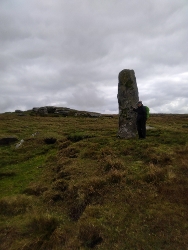
Retiring or at least slowing down!
Posted in General on Friday 1st November 2019 at 5:09pm
One of the advantages of not doing so many hours on the farm has enabled us to help with the fund raising for the new Widecombe Community Hall. We have been able to offer our time at events such as the Field Marshall tractor and trailer rides, the handler to move equipment around and our leat to have a duck race down. Gail’s latest fund raiser is a sponsored tor climb. She has taken on the All the Tors challenge which entails climbing 119 tors with a “name” space “tor” marked on the OL28 map. To date she has raised nearly £5 a tor (just under £600) and has climbed 101 tors – only 18 to go! Roll on the day we manage to build a modern, warm, multi-functional hall for all the folk of Widecombe whatever their age or mobility. If anyone feels inclined to sponsor Gail please go to https://www.widecombecommunityhall.org/make-a-donation marking the payment “119 Gail”. Thank you.

Upgrade from boggy waterhole to trough
Posted in Farm on Thursday 31st October 2019 at 4:25pm
One of our fields has several springs in it which we have collected and now use for our drinking water which is delivered around the houses, buildings and water troughs on the farm by our hydram. We have always used the overflow from the collection tank to allow our cattle to drink water in the corner of this field. We felt it was time to fit a water trough in this field now which ensures a plentiful supply of clean water for the cattle but also reduces any erosion of the soil around the stream and silt run off from cattle paddling around the soggy area.
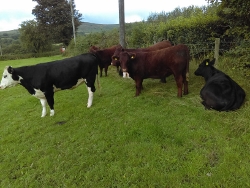
Change of Policy
Posted in Farm on Sunday 29th September 2019 at 6:47pm
Age catches up with us all and we have decided to move away from breeding cows to keeping store cattle. With a very much reduced number of cows and calves this year we have been buying different breeds of store cattle to see what suits the farm and climate and us. We have ended up with some Ruby Reds, Aberdeen Angus, British Blue and Hereford Friesian crosses. It will be an interesting new phase in our farming life.
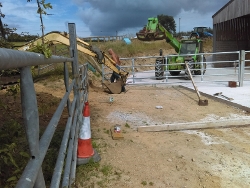
Phase 4+
Posted in Farm on Thursday 18th July 2019 at 5:28pm
We are at last on the final phase of our building project at Old Walls that we started back in 2005. We have been steadily replacing our old 1940’s buildings and making the yard fit for purpose and compliant with regulations set by DEFRA.
We now have a covered cattle yard and isolation box with protected drive in feed passage, a drive in workshop to enable machines to be mended day and night in wet, dry, hot or cold weather conditions with washing facilities, a shed to store winter bedding and machinery and finally a concreted yard around the buildings to avoid muddy conditions in winter to avoid soil erosion. Maybe as we approach the official retirement age we can finally stop building and laying concrete and enjoy the ease of the workplace we have created!

Hedgerows
Posted in Farm on Sunday 2nd June 2019 at 11:11am
The photo, some might say, is uninteresting or just “green” but look below the surface and there is a wealth of interesting plants, habitats and history. The majority of our boundaries are Devon banks, a double stone-faced bank with a hedge growing up from the middle. These Devon banks/hedges are very important as wildlife habitats as they are species-rich in flowering plants, insects, birds and mammals. From the name of our farm, Old Walls, it is also obvious that they have historic value too in agriculture for livestock containment, livestock shelter from wind, control of soil erosion and surface runoff. They also provide timber when they have been layed after many years of growth without trimming. As a casual observer I have noted Blackthorn, Hawthorn, Gorse, Hazel, Ash, Holly, brambles, wild strawberries, violets, dandelions, docks, stitchwort, celandines, ferns, bluebells, foxgloves, red campion … this list goes on and I haven’t even started on the birds, bugs and mammals!

Time for some maintenance
Posted in Farm on Wednesday 29th May 2019 at 12:01pm
Over the years on many occasions we have spent time digging out black thorns or bramble prickles from our arms and hands after working with our hedgerows ,on our Devon banks, around the farm. Many years ago, Miles even had to resort to having the surgeon take some black thorns out or his arm! Laying hedges and replacing rotten or broken fence posts are some of the worst jobs. Joy of joy we now have a mechanical post driver which can insert and drive home replacement fence posts. This has two advantages. Firstly, no prickles to dig out and secondly, we can put the posts in without having to resort to cutting back the overhanging bushes before work starts. We win and the environment wins too.

Water for all
Posted in Farm on Monday 1st April 2019 at 9:27pm
The new hydram is working well delivering a plentiful supply of water to our reservoir. But it became time to check all the water troughs on the farm in readiness for the grazing season. Suckler cows can drink gallons of water each day especially when it is hot and they are producing litres of milk for their suckling calf. If a trough is damaged a leak can empty a field trough very quickly. They then push it around trying to get at the fresh water that is managing to fill it again and that can damage the pipes serving the trough and lead to an even bigger leak. We found one of our very old large metal troughs, which was providing water to 2 fields, leaking and in need of replacement. We decided to put a new concrete trough in each field giving a dedicated supply to each field. Each is a heavier trough so if the water did become low it makes it less likely to be moved by thirsty cows!

The 10th and final year of free walks
Posted in Farm on Saturday 9th March 2019 at 5:40pm
Back in 2010 we signed into a Higher Level Stewardship agreement with Natural England which enabled us to provide up to 25 free guided walks a year. Over the years we have had many, many people including 3 year olds from our local pre-school and more mature folk up to 93! We have delivered varied and diverse content relevant to the groups visiting us including several primary schools, blind GCSE students, engineering degree students, prospective hydro developers, environmental students, art students, U3A groups, family groups, members of the Dartmoor Society, Dartmoor National Park, Dartmoor Preservation Association, WI, Natural History Society, Devon Wildlife Trust, groups interested in green energy schemes for their communities and many more. We are looking forward to welcoming another 25 groups this year, bookings are already being confirmed – will you be with one of them?

The human cost of TB
Posted in Farm on Monday 11th February 2019 at 6:01pm
Having just come in from the farm, peeled off several layers of clothes including waterproofs, hat, gloves and body warmer and plunged my hands in to tepid water (which felt like boiling) my hands have come alive enough to type. We have just completed our TB readings. TB tests are a gut-wrenching job that all cattle farmers have to do. The first day is injection day with the vet identifying each animal, shaving the injection site, measuring the skin in each of the 2 sites and then injecting them with 2 different solutions under the skin. The stress for the animals, especially the older cows who know what’s coming is hard to watch and can make them difficult to handle. Then the awful wait of 3 days before the vet visits again. This time he just needs to measure the skin on the injection sites to see if there is a reaction ie a lump. With each animal your heart is in your mouth wondering if this animal is destined to be slaughtered before her time because of a high TB skin reading. At the end of our test this year we are clear. It leaves you with a bitter sweet feeling – yippee we are clear for another year but oh lord we will have to go through this all again in a year or sooner if one of our farming neighbours “goes down” with TB. Time for a very hot cup of tea and let the nervous energy of the morning dissipate.

Our cattle's health
Posted in Farm on Sunday 9th December 2018 at 12:27pm
Recently there has been a lot of interest in reducing the use of antibiotics in farm animals and people. Each one of us is responsible for using these drugs properly to ensure maximum benefit to us and our animals and to all who follow by ensuring they don’t lose their effectiveness. One way that we have reduced the need for antibiotics is to keep our herd as healthy as possible by prevention. We do this mainly by homeopathic treatments. Our herd can be easily treated in their drinking water to prevent diseases such as mastitis, BVD, silage eye, Johnes disease, Leptospirosis, IBR, pneumonia, joint ill, red water, lice, ringworm and black leg. Homeopathic treatment is used the world over especially in organic farming and has been available in the UK since 1796. What a pity our own “powers that be” will not let us join their “Healthy Livestock” initiative unless we follow a narrow minded western medical path. Using a combination of both conventional and homeopathic treatments is surely the best way forward?

Sustainable water supply
Posted in Farm on Wednesday 21st November 2018 at 11:10am
One of the lasting memories for the Fursdon family during the 1960’s was of watching the old bungalow burning down. The fire brigade could not reach the building due to the narrow lane leading to the farm and with only a limited supply of drinking water available the family was unable to do much to prevent the total loss of the building. At the time of the fire Old Walls had a small hydraulic ram pump that provided all the fresh water directly to the farm and house but after more than 50 years of service the pipe work rusted out and we started using an electric pump. Since then we have installed a big water reservoir in our top field and fitted a water pump and hose by the house. It has always been Miles’s intention to reinstate the Hydram, using a bigger version, as the most sustainable way to transport water up hill to our reservoir tank in our highest field to keep it full all the time ready for domestic, farm or fire-fighting uses. As I write this the new Hydraulic ram pump system is being flushed out ready to start ensuring a constant supply of water directly from our own spring.

Dormice
Posted in Hydro on Wednesday 24th October 2018 at 12:56pm
One of the warm and fuzzy stories of Old Walls Hydro was the arboreal link we had to maintain as part of our planning permission to ensure the future family connections for dormice across the leat. We have many sections of our woodland that is rich in Hazel trees and coppiced hazel which produce copious amounts of hazel nuts. The nuts prove very popular for both dormice and squirrels amongst other creatures. In the picture there are hazel nuts newly fallen from the tree which are whole; others crunched open with abandon, evidence of hungry squirrels and lastly, tidily opened nuts left from the dormice. The hole excavated by the dormice is circular with a smooth inner rim and if you look really closely you can see the teeth marks running at an angle to the hole. Old Walls dormice are obviously thriving!

From New to Vintage
Posted in Farm on Tuesday 25th September 2018 at 11:16am
On 28th May 1948 Miles’s father registered the Field Marshall, Series 2, Mark 1 for the road, it was brand new. On 30th July 2018 after 8 months in the workshop the newly restored Field Marshall, now 60 years old, has been paraded for the vintage tractor enthusiasts to view at a couple of local shows. Our own very local show is Widecombe Fair which was on 11th September this year. Miles joined the parade of vintage tractors and implements in the main ring showing the visitors the progression through the ages of hay making equipment. Our Field Marshall was pulling a trailed Bamford mower (note the tower of Widecombe Church in the background also known as The Cathedral of the Moor).

Wild berry season
Posted in General on Monday 13th August 2018 at 11:04am
This very hot dry weather seems to have affected the wild berries. We have already started to pick our blackberries from the hedgerow, a favourite pastime with the grandchildren, and the rowan berries are ripening fast. I have spotted elderberries, hips and haws all still green but looking like there will be a good crop in the future. The welcome rain we have had at last in the middle of August has given all the berries the boost they need to bulk up and the sun has made them oh so sweet. Pies, crumbles, jams and plain simple stewed fruit are all on the menu. Enjoy nature’s bounty!
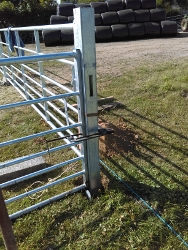
Creating a new boundary
Posted in Farm on Wednesday 4th July 2018 at 12:28pm
During this hot weather the work has to go on but the planning behind it is geared up to ensure we make best use of the cool in the early morning and late evening. Stock work tends to be done late in the evening so the cattle can cool down after being handled and remain cool for a restful night. Unlike harvest work which must happen during the heat of the day the heavier outside manual work that is under our control can be done in the cool of the early morning. Digging post holes by hand on rocky Dartmoor ground is never easy so setting up a new perimeter around our big bales and storage area Miles set himself a target of one gate a morning before breakfast. He is well pleased with the result and has been able to continue in the workshop for the rest of the day without overheating.
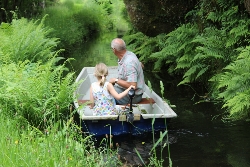

Leat maintenance
Posted in Hydro on Friday 29th June 2018 at 10:50am
Who said work couldn’t be fun? While leading our guided walks we often get asked about what maintenance we have to do on the leat. The vegetation on the leat sides have naturally grown to be an annual job. To stop the trailing brambles and ferns blocking the flow of organic debris to continue its way down the leat to the screener, we must trim the edges back once during the summer and cut them back properly later in the year. The picture shows how we use our little row boat to travel up the leat with our outboard electric motor and trim the far bank of the leat sides with hand tools. It becomes a great family affair with the grandchildren helping while they learn how to control the boat – needless to say Grampy did end up in the foliage once or twice!

The reality of farming
Posted in Farm on Saturday 26th May 2018 at 6:48pm
Before starting my farming life, I was given some very sage advice, “Where there is livestock there will be deadstock – be prepared”. It came home to roost this month when we had to take the decision to have our faithful and productive commercial cow euthanised on the farm as she had become badly affected with arthritis and we were not prepared to put her in a trailer to transport her. She had been with us well over a decade, had produce a fine calf every year and found a place in our hearts. She liked nothing better than having a tickle with a big comb or just your fingers and would move around to show you just where she had an itch– as being demonstrated by our grandchildren in the photo. She was gentle, trusted humans and adored the attention. She has and will be greatly missed – farmers are softies but realists as well.
Photo by Sand in my pocket
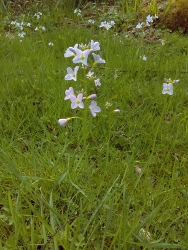
Signs of Spring
Posted in General on Monday 30th April 2018 at 3:21pm
Right on schedule the cuckoo came calling on 21st April into the West Webburn valley. Both of us heard it while we were out with the cows in the early morning. Unlike other years we have not heard it again, a sign of the times, due to declining numbers. We do have other indications of the spring arriving despite our unpredictable weather. The Cuckoo flower or Lady’s Smock – Latin name: Cardamine pratensis - is blowing around in the breeze all along the leat path. The early purple orchid is sprouting lush spotted leaves, the bluebells are just starting to flower and the Stitchwort is fairly abundant now. Add in the weeds and we have yellow dandelion, white Stitchwort, blue Bluebells and soon the purple of the orchids to add to the mix of green grasses and leaves emerging all over the woodland. Nature’s colour palette.
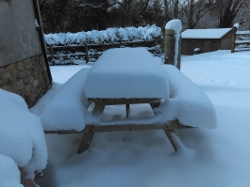
Weather vagaries
Posted in Farm on Monday 26th March 2018 at 12:22pm
What a month March has been. We arrive home from abroad 30 hours late at the beginning of the month to freezing temperatures and heavy snow, like much of the UK. Then came the floods as the rain thawed the snow in double quick time. A week of showers and soggy ground followed which has necessitated our cattle staying in the sheds for longer than normal as they would have poached the ground to a muddy puddle. Luckily, we have enough winter food and bedding straw to see us through. Another bout of heavy snow saw us trapped on the moor for a few more days and today 26th March has seen the last of the drifts melt away in the sunshine! With more snow showers forecast for the hills over the Easter weekend you have to wonder what April will bring. Anyone for tea on the patio?

Kelt protection
Posted in Hydro on Saturday 3rd February 2018 at 5:48pm
Following the life cycle of the salmon that run up the West Webburn we have just completed our Kelt protection. The adult salmon run up the river to spawn above us, I have mentioned our fish wheel in a previous news article, protecting them on the way up. On the way back down the river after spawning about 5% will live to get back to sea the remainder will die naturally. To help the 5% we have a static grid which stops the kelts entering our leat and therefore ensures they travel past our system by swimming over the weir to continue their journey to the River Dart and eventually Dartmouth. This year we were actually able to show a visiting group how it works – not many folk choose to visit in cold, wet, windy January!

Farewell old oak
Posted in General on Wednesday 24th January 2018 at 12:17pm
Following 5 named storms in late 2017 we have already had Eleanor, Fionn, David and we are now experiencing Georgina’s forceful winds and rain in 2018. The rain we like – it keeps the turbines spinning but the wind has been so destructive. In accordance with Natural England’s preference under our HLS we have left ivy to climb into our trees but the result is as you see in the picture. Given wet ground and high winds the big oak tree covered in ivy could not stand the pressure of the constant battering of the high winds and lost its battle to stay upright. Some of you may remember the old oak tree beside the leat as when we built the hydro electric scheme 23 years ago we deliberately wiggled around this old, old oak tree. Alas NE with the aid of nature has brought her down despite our best efforts to keep her!

Farm recycling
Posted in General on Thursday 30th November 2017 at 9:26pm
We have had a stone mantel aging under the woodland canopy for the last year to mellow the glaring whiteness of the newly carved granite. Anyone who farmed in the 1960’s or before would fondly remember granite rollers that were used each spring in the fields preparing the grass for cutting later in the year. One broken roller has been recycled to become part of our fireplace surround. We had it cut in half and set on small granite blocks holding up our nicely mellowed mantel piece. Sorted.

Fish Wheel
Posted in Hydro on Tuesday 24th October 2017 at 11:39am
The seasons seem to roll around faster than ever, and earlier this month it was time again to put our fish protection in place for the adult salmon that are about to start running up the river to spawn. Often folk ask us how we fit the fish wheel in place and the picture illustrates how with the help of the digger we can safely fit the wheel in its channels in the tail race without putting anyone at risk. It is also pleasing to know that a few weeks after fitting the fish wheel Miles has already seen salmon not only above our powerhouse but also above our weir this season.
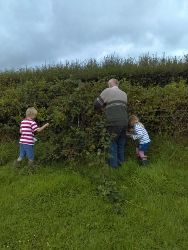
Time to take enjoyment from the farm
Posted in Farm on Monday 28th August 2017 at 11:07am
The second cut silage is cut, turned, baled and wrapped which finishes the harvest for this year. In between cleaning all the harvest equipment up and lightly oiling it before storing it for the winter there is time to enjoy the free harvest from the farm and teach the future generations what fun it can be to pick the fruit in the afternoon and eat it in the evening. This picture is showing our grandchildren leaning about blackberries and they tell me the crumble they had for supper was delicious. During the year we make use of sloes for sloe gin, elderberry flowers for cordial and elderberries for jam, crab apples for jelly to go with pork, hips for rosehip syrup, haws for a fruit butter and rowan berries make a beautifully coloured jam. We also have gooseberries growing wild in our hedges on the farm for pies and wild strawberries to eat as soon as you find them!

Farm assured produce
Posted in Farm on Friday 28th July 2017 at 4:03pm
One of the office jobs that is on-going is keeping records of almost everything we do on the farm. I have recently been inspected so all our cattle can be sold with the Farm Assured tag. You will know this as the Red Tractor Logo that you find on British products in the shops. To achieve this status we have to show accurate, up to date, quantitive, identifiable and comprehensive records on:- emergency plans and procedures; staff and labour providers eg training undertaken; traceability eg ear tags and assurance status of animals bought; vermin control, how, what, where etc; housing, shelter and handling facilities are well kept, large enough and suitable for the livestock kept; feed and water, adequate and suitable; animal health and welfare including an annual herd health plan, records of any treatments and plans for emergencies; bucket reared calves are provided for as they have specific needs; biosecurity and disease control needs a written policy which is carried out in the real world, animal medicines and husbandry procedures are recorded accurately and undertaken by suitably qualified stockmen; fallen (dead) stock are dealt with in a timely manner effectively and efficiently; livestock transport must be adequate in size kept clean; environmental protections and contamination control carried out by certified operators, plans kept and records updated regularly. Whoever said cattle farming was all about “working outside in the fresh air” has never farmed!

New crop of calves
Posted in Farm on Thursday 1st June 2017 at 12:33pm
Only calving a dozen cows this year for us seemed to be a breeze until it started for real. The first calf arrived over a week late but was fine. The second followed a day later and was to keep 5 of us busy for several hours. A new heifer coming into the herd was trying her best but once examined by us and then the vet the decision to “take the calf out sideways” was made. The caesarean was done by 2 vets whilst the cow stands secured by a halter and kept as still as possible by husband and son. Nearly an hour after the first anaesthetic injection a healthy bull calf emerged into the world. My job starts now acting as mum, cleaning the calf up and encouraging him breath and then to stand. Yet another hour later and the stitching on the “15 inch zip” is completed up the side of mama and the calf is ready to suckle. The next 5 calves have been a mixture of “do it yourself” and “help pull” with the calving tool. All arrived alive and are thriving now which is the main objective. Only 3 to go…

Harvest
Posted in Farm on Wednesday 31st May 2017 at 12:52pm
Under our HLS agreement we can start cutting our silage fields on 1st June, in an ideal world we would have started already to make use of the beautiful weather we have been having but Natural England works by the calendar, not nature, when prescribing stewardship schemes. Our workshop has been busy while the boys are mending, maintaining and making ready all the harvest equipment including mower, turner, baler and bale wrapper. The tractor and handler get a good pressure wash after all the winter work to remove all the dung that accumulates over the months of winter yard work. The weather forecast for the 1st June is rain so we will have to wait a little longer before he harvest begins.

Hail & snow in spring
Posted in General on Wednesday 26th April 2017 at 10:05am
Once again the seasons are getting mixed up with high temperatures first followed by hail and snow on the 26th April! We have had very little rainfall since the end of March which is unusual for Dartmoor. The river flow is falling everyday but the excessive amount of sun has been enjoyed by our cows as they were able to go out into dry fields, although they are still returning to top up their feed with silage from the sheds. We also benefit from our solar panels coming into action much earlier in the year than normal. The wild flowers have been abundant especially the wild violets. We have also noticed an abundance of bees on our heather and orange tipped butterflies who are enjoying the wild Cuckoo Flowers – supposedly called this as they flower around the time the cuckoo’s start to call. This year that is correct as I heard my first cuckoo call on the 24th April at 6am whilst checking our calving cows.
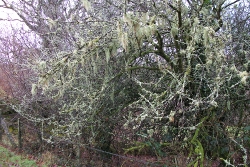
Lichen
Posted in Farm on Wednesday 15th February 2017 at 11:38am
Lichens are a close partnership between a fungus and an alga which is interwoven to appear as a single individual organism. They come in many and varied forms. The picture shows a good example of beard and hair lichens in abundance on our trees just below Old Walls house. Lichen absorb water and minerals from rainwater and directly from the atmosphere, over their entire area. Different species grow in more polluted areas, e.g. industrial sites, than grow in our beautifully clean air on Dartmoor. As a general rule the greener the lichen the cleaner the air, the more yellow varieties the more polluted the air. One interesting fact about lichen is that the litmus dye used so widely as an acid/alkaline indicator in chemistry comes from lichens.

Brashing
Posted in Farm on Monday 30th January 2017 at 12:54pm
After 20 years of growing, with only the first few years being tended, the new wood we planted is ripe for brashing. Technically this means “Removal of the lower dead branches, up to about two metres, of trees in a stand”. From the picture, you can see sky through the trees to our grazing field above. This half of the wood was brashed last winter. We are about to start on the other half nearest our intake. It’s hard heavy work all done on a 45% angle, hence doing it over 2 years. Hopefully it will allow the native bluebells, orchids and violets to flourish and it also allows us the pleasure of being able to walk upright in amongst the trees.

It all takes a very long time...
Posted in Farm on Thursday 29th December 2016 at 4:14pm
Last year on 19th January I posted a picture of our bucket fed baby calves. A year down the road and look how well they have done. They are still as friendly as ever and demand to be tickled, scratched or fed – preferably all three! This summer will see them go to bull and we wait until 2018 for them to calve and yet another year until 2019 when we will eventually be able to sell their calves and finally reap some financial benefit from caring for them and feeding them since November 2015. Cattle farming on the hills is a very long term venture.
Happy New Year!
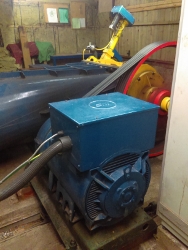
Lightning strikes!
Posted in Hydro on Wednesday 30th November 2016 at 12:26pm
Just over a week ago we had a terrific thunder storm, short lived but destructive. I managed to disconnect all my communication equipment phones, computer, printer/scanner, tv etc after the first bump of thunder. Just as well because just a few minutes later about 11pm an almighty clap of thunder followed very rapidly by a powerful strike of lightening caused havoc around and about. We didn’t come away unscathed. Our deep freeze “died”, the hydro’s screener battery charger had a similar fate but the major damage was done to our big generator in the powerhouse. The smoke that poured out of it was a bit of a giveaway! Miles being ever resourceful had taken out the damaged one and fitted the replacement (which he keeps on the shelf all 530 kilos) and we were up and generating again within 48 hours!
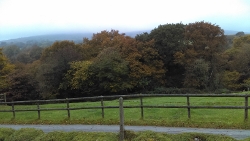
Autumn colours
Posted in General on Sunday 30th October 2016 at 11:27am
This autumn has come later than usual for us. We have had little rain during the summer and early autumn and as yet no real rain clouds in sight. The down side of this is that the rivers are still very low but the up side is that the cows are still able to be out in the fields. The ride out with the hay in the mornings to feed them allows us to see the autumn colours in the trees and there is some typical low hill cloud or mist in the mornings before the sun burns it off. The tree colours are changing every day and Corndon Tor comes and goes into the mist in our ever-changing view.

Thinking towards winter
Posted in Farm on Friday 26th August 2016 at 12:49pm
The corn harvest is continuing apace up country in the arable areas of the south of England. This is where our straw comes from to bed our cattle down during the winter months. We bring it in as soon as possible after harvest to avoid any of the straw getting wet in the outside stacks that are awaiting lorries to transport them to cattle country. Miles brings ours in as he is a relief driver for the local H&M Retallick haulage firm. We can only get the lorry close to the buildings at Old Walls when the fields are dry enough to drive the lorry and drag on. This year has not been a problem as we have had very little rain and on a nice sunny day it becomes a family day. You can see the lorry and drag in the field next to our buildings with North Tor on Spitchwick Common in the background.

Weir maintenance
Posted in Hydro on Thursday 28th July 2016 at 12:03pm
During the last couple of months, we have had surprisingly little rain – real rain, Dartmoor rain. Yes, we have had drizzle, mizzle and the odd thunder shower that lasted maybe half an hour but none of our real prolonged heavy rain that we are used to. In the summer months it can be of benefit to us as it is this year. The river is so low that we have been able to channel all the river water through big 4-inch syphon pipes and two pumps to dry up the area around our weir. We have been able to do some major maintenance work safely, for us and the river creatures, on the weir. This is the first major work on the weir since its construction in 1995.

Silage hold up!
Posted in Farm on Monday 27th June 2016 at 11:04am
We expect to cut, wilt and bale our 1st silage crop of the year in June. This year we were on track but had a temporary hold up due to a fawn. Our lovely long cutting grass is the perfect place for Row deer to hide their fawns. We suspected that this may have happened as we watch out for our resident doe and had spied her a couple of times in Lower Mills Close before we went to cut it. Miles managed to spot the fawn before he cut the headland and was able to move it into the long grass in the middle of the field in the hope that when he came back to cut the centre of the field the hind would have moved the fawn to another safer field, which indeed was the case. Mean while we were able to take the photo with my had in shot to show how small these animals are and how difficult to spot when mowing.

King of the Castle
Posted in Farm on Thursday 5th May 2016 at 1:26pm
When the sun shines even the calves want to play traditional games but cannot decide who really is “The King of the Castle”.

Our latest award
Posted in General on Sunday 24th April 2016 at 11:03am
Yesterday we joined The Dartmoor Society for their AGM. They describe their society as “An independent voice for those who find Dartmoor a source of livelihood or inspiration”. With this in mind we were thrilled to be presented with the 2016 Dartmoor Society Award. They have taken a keen interest in the development and maturing of our hydro-electric scheme from the beginning. The award is a huge honour, thank you!

2 whole days dry!
Posted in Farm on Wednesday 17th February 2016 at 7:18am
What a frantic couple of days Miles and Luke have had. We have just experienced 2 whole days of dry weather this winter. This enabled urgent tractor work to be undertaken on the farms between dawn and dusk and every other daylight minute, even meals were taken in shifts to keep the tractors moving before the rain came again. Dung which has been accumulating during the winter from scraping out the feed channels in the cattle sheds was finally loaded up in the muck spreader and spread lightly on the fields which will be used for growing grass for the silage crop in June. This is a good natural source of nutrients. The other important job was hedge trimming. Under our HLS we are severely restricted on when we can trim hedges – only during January and February. This has proved particularly difficult over the last few flood ridden years as you cannot take the tractors on sodden soil – it damages the soil structure which has long term productivity issues. Roll on the spring!

Baby calves
Posted in Farm on Tuesday 19th January 2016 at 11:58am
To keep our herd productive and invigorated we have to replace some of our “old girls” from time to time. We have found that the best way is to buy baby calves and bucket rear them ourselves. This enables us to buy the right cross breed, for us that is Hereford Friesian cross, who turn into great mothers and cope well with our wet, windy and cold climate at 1000ft. This autumn we bought 3 and the corresponding number of old cows will be fattened and sold during the summer months. Rearing the calves on our farm also gives them the chance to develop immunity to the bugs and bacteria on our farm. They adjust to the mineral and trace element levels present in our soils, and therefore grass, before they become mothers themselves for the first time at about two and a half years old.
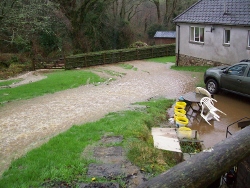
Flood 6 Water Water Everywhere ...
Posted in Farm on Thursday 31st December 2015 at 6:51pm
Once again we have experienced the power of nature with the quantity of rain dropped on Dartmoor in a very short space of time. We watched the garden flood in just 30 minutes and a lake appear in one of our cutting fields. Our daughter’s garden disappeared under water too. As the rain flowed off the road, across our field through a hedge into Olands garden, down past the chicken coop, down again across our lawn and into the woods, it is hard to see how much more as farmers we can do as the Environment Agency and politicians are suggesting.

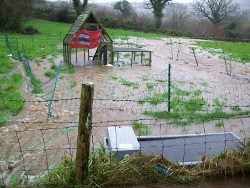
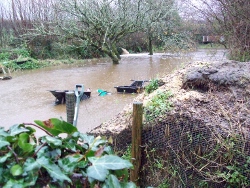

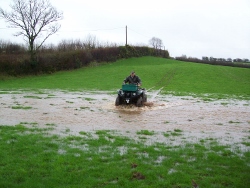

Autumn leaves
Posted in Hydro on Friday 6th November 2015 at 12:22pm
The new screener controls have been put through there paces over the last few days while autumn leaves are blown off the trees in vast quantities. Our leaf mould pile is growing daily and will provide some good soil conditioning compost for the fields in a couple of years and all for free!

Screener upgrade
Posted in Hydro on Friday 30th October 2015 at 8:56pm
After such a difficult year for the family with loosing Miles’s mum and Gail having breast cancer at last Miles has had time to get back to upgrading the screener controls. He has built a brand new home for all the switches, circuit board, batteries and pipes needed to operate the automatic screener efficiently. It is primarily created of concrete which is flood proof so if ever the conditions get so bad the leat overflowed at the forebay the electrics will be safe – with the climate changing you never know when the next flood warning is coming. Grand-dad also had time to show the grandchildren how it all worked.

New additions
Posted in Farm on Sunday 27th September 2015 at 9:27pm
To help our self sufficiency along we have added a couple of chickens to our livestock list. They have such quirky characters and entertain us each evening while they have their hour of freedom in the garden. We have too many foxes about to allow them unrestricted freedom and plenty of cover in the woodland for the predators to wait their opportunity. With just the two of us at home it serves us very well with enough deep yellow yolked eggs each week to bake a big sponge, have some boiled eggs in our lunch time salads and enough left over for an omelette supper each week. Sorted!

Wild flora
Posted in Farm on Monday 31st August 2015 at 7:49pm
As the autumn advances and the days become cooler and damper it gives the opportunity for new growth. In one of our “species rich” fields, that Natural England identified, we have an old tree stump decorated with a colony of fungi. This field is treated according to our Higher Level Stewardship prescriptions – no fertilizer what so ever, no lime, no spraying, no harrowing and much more. For the reduction in farm production in this field we get compensated through our HLS and the unusual flora benefits.
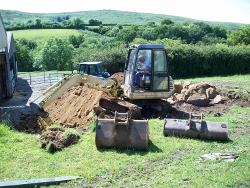
Time to continue the building
Posted in Farm on Sunday 26th July 2015 at 5:04pm
At last the urgency of calving and silage harvest is over and we can organise our time as we see fit rather than the cows or the grass dictating what we do and when! Obviously we still need to be mindful of what the elements can throw at us, like today with heavy rain and gusting winds. Luckily a few days ago the weather was fair and the ground dry enough to do some more work on our farm buildings which needed a track to the straw barn dug out to give a gentle curve around the building as well as a safe gradient. Miles has efficiently dealt with the topsoil, subsoil and the ever present Dartmoor granite. All that has been dug out has been gainfully used around the farm in other places. For example the subsoil then topsoil has been used on other fields to level out areas to enable then to be machine friendly or to increase the depth of topsoil where it is thin. Recycle, re-use as ever is our motto.
Wildlife on the river
Posted in Hydro on Sunday 10th May 2015 at 10:46pm
We have just seen the beautiful little dipper flying out from under the powerhouse on a fishing trip, obviously nesting again under the floor above the white water that leaves the turbines. Look up and the heron will not be far away on the river patiently waiting for his next meal. Observe from a distance and watch the pair of goosanders scim the surface of the river until they see a fish and then efficiently dive for their quarry. Walk along by the water in the moonlight and catch a glimpse of the otters once again fishing the West Webburn after a lengthy absence. With all this hunting going on providing nourishment for the natural wildlife it is clear we have an abundance of fish this spring in the river. Something we and our EA contact can verify when we recently, on three occasions, counted over a hundred salmon and sea trout smolts in our leat just before we released them down our “fish pipe” to continue their journey to the sea.
Sad news
Posted in General on Thursday 30th April 2015 at 9:48pm
Miles’s family has been living and farming Old Walls for nearly 70 years. This month we have had to say goodbye to the last of the second generation of Fursdon’s – Miles’s mother has just recently died. It leaves us as the oldest generation now but we know that there are another two generations already in residence which is heart warming for us. Our job now is to continue doing our best in our guardianship of the land to leave it in a better state for our descendants to take it on in the future. RIP Liz.

Winter jobs
Posted in Farm on Wednesday 31st December 2014 at 6:57pm
The obvious jobs are the daily task of feeding silage to the cows, scraping the yards of slurry, spreading new straw on the cattle beds and breaking ice on the water troughs. During this time we also check the cattle over to make sure they are healthy with no foot problems from being on concrete floors or eye problems like silage eye. In January we will treat all the adult cattle for liver fluke and later with a mineral supplement bolus to counter the low levels of copper, cobalt and selenium and various other trace elements on our farm. Towards the end of winter we will wean the cows to give them a rest before they calve again in spring. With the short amount of daylight to work in outside and long dark nights it is time to start the workshop jobs in earnest; servicing all the machines in our new workshop, mending and creating new pieces of kit to make our work easier or more efficient. When the weather and soil conditions are right the tractors are fired up for dung spreading or hedge trimming (we are only allowed to cut hedges between 1st Jan and 28 Feb). This is just a small sample of what needs to be done and I haven’t even mentioned the office work. This time of year is often referred to as the quiet time of year – I have yet to work out why!
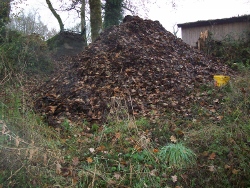
Autumn harvest
Posted in Hydro on Thursday 27th November 2014 at 12:59pm
This is the time of year when we start to harvest the beginnings of our wonderful soil conditioner – leaf mould. As the autumn colours arrive so does the inevitable fall of leaves from the trees. Many of these end up in the rivers especially after heavy rainfall having been washed off paths and roads into the waterways. As we have 10ml screening at the end of our leat we collect a massive amount of leaves each autumn. We are about three quarters of the way through the fall of leaves this year with most ash, cherry, beech and hazel trees already bare. Another couple of good frosts will see most of the remaining leaves fall, mostly oak. We pile up the leaves and let them rot down over the next year. Next September we turn the pile of partially rotted leaves just before we start collecting again. After two years of composting down we have the most wonderful leaf mould soil conditioner which benefits our farm fields. Natural recycling at its best!

Fungi
Posted in General on Saturday 25th October 2014 at 3:59pm
This 8-9 inch bracket fungi was growing in our wood on a piece of deadwood. It is amazing how it launches itself out of the birch bark. A quote from http://www.first-nature.com/fungi/piptoporus-betulinus.php “This large polypore develops from a small white spherical swelling on the side of dead or living birch trees. Barbers used to 'strop' or sharpen their cut-throat razors on tough, leathery strips cut from the surfaces of these polypores, and so they became known as the Razor Strop Fungus.” A history lesson all of its own.

Maintenance time
Posted in Hydro on Sunday 31st August 2014 at 1:20pm
In 1996 we fitted our Cink turbine and it has successfully been working to produce electricity ever since. Apart from everyday maintenance e.g. greasing and one bearing replacement it has never let us down. During this summer the rivers have been very low so we decided to finally take the turbine out and have a look at how it had faired. The picture shows the farm tractor slowly edging it out of the power house after we first removed the side wall completely.
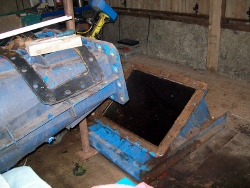
Maintenance time
Posted in Hydro on Sunday 31st August 2014 at 1:19pm
This picture shows the hole left by removing the turbine. The draft tube can be seen below where the water flows back to the river after it has been through the turbine and the pipe suspended above is the transition piece which turns the round pipe into a rectangular pipe which fits the turbine inlet that you can see on the photo of the turbine above. We have since taken out the transition piece as it is much easier to clean it up and repaint it in the workshop.

PV
Posted in General on Thursday 31st July 2014 at 11:01am
As with all farming and renewable energy systems we are very reliant on what nature throws our way. We have always been strong advocates of run of the river hydro power schemes as its production parallels the human need for energy. Think about when you use most energy in your homes – the winter, with the heating on, hot meals and soaks in a hot bath on cold winter days. Contrast that with the summer when the heating is off and windows open, salads or BBQs for meals and cool showers at the end of the day. Our hydro scheme produces the most power in the winter and the least in the summer due to the rivers running high in winter and low in summer following the natural rainfall pattern. To complement this we have added a 10kW PV system to our renewable energy range by installing 40 PV panels on our farm buildings. It, in contrast to the hydro production, produces most electricity during the summer months from sunshine thereby levelling out our production low spot in the summer. This is important for us as the summer is the time when we do our maintenance on the leat, intake tank, spillway and forebay tank which necessitates powering down the hydro turbines but with the new PV we can still be self sufficient in electricity.
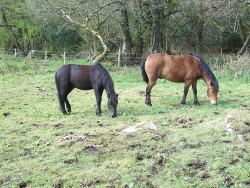
The Dartmoor Pony year
Posted in Farm on Wednesday 21st May 2014 at 12:26pm
As well as the work we do with the cattle we also keep Dartmoor ponies. The Dartmoor pony year is dominated by checking the ponies on the open common daily. We drift the ponies off in the autumn over 2 days with all the other commoners, sort them out and bring ours home to wean their foals and worm the mares if necessary. If any of the mares are looking in poor condition they stay on the farm until they are well enough to return to the common. The foals are kept on the farm until we can find a buyer for them, they are used as conservation grazers, they are old enough to return to the common as part of our herd or as a last resort we sell them to the zoo for lion meat. If we are keeping them we have them chipped, inspected and passported as heritage Dartmoor ponies. The colts are gelded by the vet when they are about a year old. With our stallion we maintain a herd of 28 on Spitchwick Common.
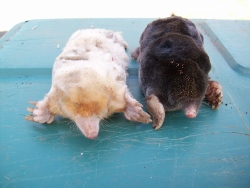
Future planning
Posted in Farm on Tuesday 1st April 2014 at 12:13pm
We are at the time of year when we have to start thinking about the future and all the things we need to prepare for. Uppermost in our minds at the moment is the field work. We need to harrow and roll all the fields we are laying up to cut for silage and hay later in the summer. This has to be done when the ground is moist enough to roll flat but dry enough not to leave tractor wheel ruts so when we come to cut the grass we keep soil out of the grass mixture to be made into big bale silage. One of the many pests we have to deal with are moles. They love the moist soil beneath grass as it contains so many worms but the mole hills they leave behind can contaminate our grass silage and one mole hill can rot one big bale of silage. The answer is to catch the moles in the spring thus eliminating the mole hills. This year we have been successful with our catching programme but also surprised by catching, for the first time, a white mole. Rare but not unheard of.
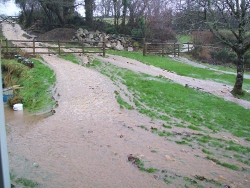
Floods again
Posted in General on Friday 3rd January 2014 at 3:24pm
Like everyone this autumn and winter we have had to cope with the wet and windy weather at home. We feel we have one advantage where we live when it’s such heavy rain in a concentrated time – we live on the side of a hill! Although noisy, dramatic and it leaves the lawn in a real mess the excess water rushes past us from the field, down the track, divides up across the lawn to lap up against the house but continues past us into the woodland at speed. On the farm we have had to bring the cows into winter housing as they were poaching up the fields too much and the hydro electric scheme has to be constantly monitored to ensure the leat doesn’t become overwhelmed by excess water. The lowered sluice gate at the intake does a grand job at sending most of the water on down the river, the spillway does the rest by keeping the leat’s water level as constant as possible but with the massive floods we have been getting it is a constant concern that the mighty power of the West Webburn is kept under surveillance.

Replacement farm buildings
Posted in Farm on Monday 30th December 2013 at 7:29pm
A well earned rest and cuppa for Miles and Luke who have spent many many hours over the last couple of years building our new 5 bay barn. This has replaced our range of 1940’s buildings which were really on their “last legs” and not fit for purpose anymore. At last the barn is weather proof with roof, block wall bases and boarding or Yorkshire boarding for the walls. We had to have help laying the 30 cubic meters of ready mixed concrete and for the electrical fixtures but this like all our projects is truly home built with the families hard graft. It will be a joy to use this winter and many more to come!

The rivers are full again
Posted in Hydro on Thursday 31st October 2013 at 6:42pm
What a difference a few weeks makes. Not only is the leat full but we are back on full power with water to spare. The fish wheel is back in place, in the tail race, to protect the adult salmon and sea trout as they progress up the West Webburn to their spawning grounds. The automatic screener at the end of the leat is on over time with the autumn leaves beginning to fall from the trees in their thousands every time we get a “good blow”. We have certainly had our fair share this last week with the storm named St Jude passing over us. We have had no major structural damage, a large branch falling on the garage put a dent in its roof and several other limbs have broken off trees but caused no serious harm.
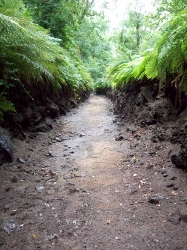
Leat maintenance
Posted in Hydro on Wednesday 11th September 2013 at 12:26pm
Following this very dry summer we have made good use of the low river levels to do as much leat maintenance as possible while minimising the loss of potential electricity generation.
The first, entertaining but time consuming, job to be done before we can work on an empty leat is to collect all the brown trout that usually live in our leat and pop them back into the river. This is a game of speed and skill like big kids fishing in the stream with big fishing nets! To do this we lower the water level so we can work with waders on to hand net the fish and transport them in buckets of clean water to the river. Once the leat is fish free we can pump out all the pools of water to work on a dry bed. We deal with any leaks that may have occurred in the bank, hand pull all the weed that has started to grow in the bottom of the leat and trim the vegetation along the top edge of the banks. We work as quickly and efficiently as we can to reduce the days it is empty and this year to ensure the leat is full of water for our next guided walk tonight!
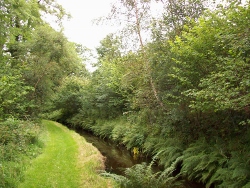
Hazy days of summer
Posted in General on Friday 6th September 2013 at 11:19am
For the first time since Miles was born at Old Walls he has seen otters in the West Webburn. The first sighting was two otters playing in the river near our tail race and the second time a single otter swimming and diving in our leat. Yet another protected species we have inhabiting our hdyro system and farm. They join the dormice which live in the wood and have an arboreal link of hazel across our leat to use, the Greater Horseshoe bats that use the river system and our leat to help them navigate while filling up on insects in our oak woodland and the Marsh Fritillary butterflies that nectar in our conservation field which was created by the leat dividing one big field which has now become part grazing, part woodland and part conservation grazing.

Food for free
Posted in Farm on Wednesday 14th August 2013 at 1:09pm
What a difference in the weather and for us a huge difference is what we can do and when we can harvest. One of the joys of walking around the farm in the summer months has always been the wonderful surprises of the hedgerows. This year I have already picked a glorious crop of gooseberries, wild strawberries, sloes and raspberries. I am now looking forward to the blackberry crop which is looking good for jam, wine and good old fashioned crumble for pudding. We will also benefit from elderberries for jam, rosehips for syrup, crab apples for jelly sauce and hazelnuts to crunch later in the year. Money cannot buy the joy of harvesting food for free!
Pay day
Posted in Farm on Saturday 27th July 2013 at 8:39pm
Payday comes but once a year for us from the cattle. Each year we calve our cows in spring and the cows suckle their calves for 10 months – hence the name Suckler cows. These calves are then weaned and when winter finishes, which was very late this year, they go into the fields to eat nutritious young spring grass. When they are 15 or 16 months old and are looking really healthy having lost their shaggy winter coats and are growing well we take them to Newton Abbot Market and sell them for other farmers to fatten them. It is an exciting day but also nerve wracking as the price we receive will depend on who is looking for cattle that day and what price they are willing to pay at the auction.

Flora of spring
Posted in General on Thursday 30th May 2013 at 5:23pm
An explosion of colour has at last come to the woodland and leat walk. We have a profusion of blue bells under the oak canopy. In places they are mixed with other colours, white of the wild garlic, purple of the early purple orchids, pinks of the red campion, yellow of buttercups, a variety of greens from ferns and mosses to mention just a few of the more well know plants. It makes the walk beside the leat a real joy as well as part of our work. The leaf canopy of the oaks, ash, hazel and beech are slowly reducing the view of the sky about 3 weeks behind our neighbouring areas of Bovey Tracey and Ashburton.
Visitor Comments
Posted in Hydro on Wednesday 1st May 2013 at 5:19pm
Some quotes from a recent visit to our hydro power scheme from a local amenity group:
“Carol and I were amazed at your hard work and enterprise on you hydro-power scheme!”
“Really great, very interesting and inspiring.”
“I must really congratulate you on your engineering achievements…”
“We all enjoyed your very informative descriptions and walk through your delightful location.”

Sunshine!
Posted in Farm on Wednesday 24th April 2013 at 4:32pm
What a joy having a few hours of sunshine is, it lifts the spirit and work pace! The lack of sunshine last summer has had a lasting effect on our cows. We would normally expect to be 75% through calving by now but we have only had 25% of our cows calve so far this spring. Having checked the feed, mineral supplements and health of our cattle I pondered what could be the cause of so many cows calving late. Sunshine is the answer or lack thereof! Last year when the bull came to visit it rained for the first 4 weeks he was with our cows, he and they huddled under hedges to shelter from the worst effects of the heavy downpours with never a thought to “getting together” to mate and make this years crop of calves arrive on time! Time will tell if my projection is right, that we will be busier than usual with calving cows the first week in May (2013) following a glorious week of sunshine in late July last year (2012) – 9 months ago!

Some of the signs of spring
Posted in General on Wednesday 24th April 2013 at 4:24pm
Whilst on my early morning check of the calving cows just before the sun peeps over our horizon the countryside seems to be wide awake and buzzing with life. Every morning since the 20th April the cuckoo has been calling in the valley, the rest of the bird’s busy singing in the dawn. The chickens are telling everyone they have laid an egg and the calves are all stirring to have their first drink of milk. On the next door farm the lambs are frantically bleating for the ewes amongst the flock and the distant rumble of the West Webburn is the constant background refrain. The urge to stop and soak up the atmosphere is strong and only wins out after I’ve checked to see if any calves are being born. It’s then that you notice the tiny shoots of grass valiantly coming through, the catkins, the blackthorn flowers beginning to emerge, the celandines in the banks, the subtle change of colour to the bare trees where their buds are developing and giving the appearance of a red brown hue and the huge show of colour in the garden heathers. Nature is a powerful thing, always balancing herself through the seasons.
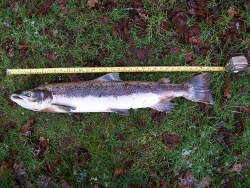
Salmon are thriving
Posted in Hydro on Sunday 31st March 2013 at 11:48pm
It’s good to see evidence that salmon are thriving on our river, theWest Webburn. A previous article I wrote told the story of the salmon smolts travelling successfully past our hydro scheme to continue their journey to the sea. During this winter we found a dead Kelt upstream of our system which measured 33” long. It is very pleasing to know that these magnificent creatures have managed to complete their journey fromDartmouth, despite the fishing lines. This is clear proof that they are reaching their chosen destination and are able to spawn successfully in the upper reaches of theWest Webburn.
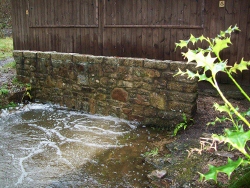
Truly awesome renewable energy!
Posted in Hydro on Friday 1st February 2013 at 5:53pm
Just like everyone else we have been dealing with the excess of water everywhere – on the farm, around our home and yes even with the hydro electric scheme. For the latter we have been monitoring, very closely, the high water levels in the run off periods after the very heavy downpours. The effect on the river is very fast and it can easily catch you out and over top the leat bank if we don’t manually restrict the flood waters with our sluice gate at the intake. The power house end can still be excessively high as you can see from the picture. The tail race is underwater on the downstream side and the arch way beneath the powerhouse is full - compare it to the picture on the About Us page.
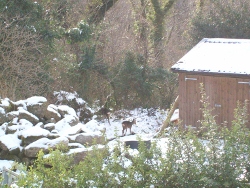
Winter visitors
Posted in General on Sunday 27th January 2013 at 4:02pm
From floods to blizzard we are no different from anyone else, nor is the wildlife. They have to deal with the consequences too. Food is harder to find when snow covers the ground and the wildlife becomes braver. We often have fleeting glimpses of deer in our wood but as the photo shows they loose some of their shyness when needs must. Hard for them, but a joy for us to watch.
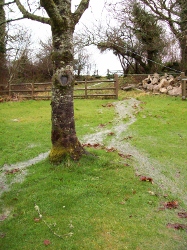
Paperwork deadlines in the rain!
Posted in Farm on Monday 31st December 2012 at 12:23pm
As I watch the Cherry tree divert the flood waters around it in our garden I have to wonder if it will survive this constant soaking of its roots or drown! The farm fields are not much better with pools and small lakes appearing after heavy rain where grass should be. Much time is being spent by farmers around the country filling in their Soil Protection Review, deadline 31-12-12, to satisfy the powers that be that we are aware of waterlogged soils and are able to show how we will treat them! We have to identify each field by its number, describe its soil type, the use of the land, soil issues eg run off carrying lots of silt, do a risk assessment on the soil and identify measures to be taken if the soil has issues - that's just to mention a few of the items to be addressed. This is just one of the many forms, assessments, surveys and registers we have to keep for the government.
Beware looking up on ladders!
Posted in General on Saturday 29th December 2012 at 2:59pm
It’s good to be back on the net again. Many of my duties changed over the last few weeks after Miles’s had an accident, broke his wrist, dislocated a finger took a blow to the chin which broke a tooth and misaligned his jaw plus lots of scraps and bruises. I found myself back on the farm while he recovered managing to cover the stock work with the help of Luke, our son. While waiting at A&E it became obvious to us that blacking out and falling like a rag doll off a ladder, whilst looking up, (the ladder stayed in place!) is relatively common and a well known reason, to the medical profession, for this sort of accident. The big artery at the base of the skull gets squeezed and restricts the blood flow to the brain hence the black out. Having attended several sessions with the H&S folk why is it that the section on “safe use of ladders” has never flagged up this fact?
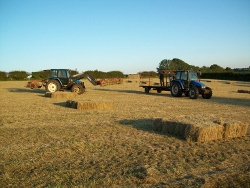
Hay and silage harvest complete
Posted in Farm on Saturday 25th August 2012 at 1:39pm
With the rain falling yet again it is with a thankful heart that we can at last say our harvest is over. The last of the big bale silage was wrapped this morning before the heavens opened. We have managed to make enough silage for the winter period and have some small bale hay which gives us some flexibility when feeding small groups of cattle in the autumn, the odd sick animal or if we get caught with snow this winter we can carry a small bale on our backs to stranded animals. Big bales are easily moved as long as you can use a tractor not always the case in heavy snow or very icy conditions!
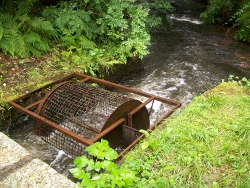
Summer generation
Posted in Hydro on Saturday 25th August 2012 at 1:29pm
What a different year this has been for generating electricity. We have rarely had to use our small turbine as the river has hardly ever dropped to what is normally consider summer flow levels since March’s heat-wave! Apart from generating all that renewable energy the flow levels have obviously had an effect on the river’s inhabitants. We have already put our fish wheel in to guide the adult salmon past us as they travel up to the head waters to spawn. The beginning of August is really early for this stretch of river to have salmon and sea trout running, but they are there, and going past us safely in the heavy fast flowing river water.

Silage and showers
Posted in Farm on Monday 2nd July 2012 at 1:28pm
What a month June has been, busy, busy, busy! We have been trying to dodge the rain and showers to make some silage for the cows winter fodder and conducting tours for WWT in between. We are about a month late with our harvest and the feed value of the crop slowly drops as the days go past, while the crop continues to bulk up. The lower feeding value needs to be reviewed as the winter goes along to make sure we are not under feeding our cows nutritionally while still “filling their tums” with the bulk. Our cows are still milking during the winter suckling their calves, so the nutrition needs to be correct or health problems start manifesting themselves. We work a family system with silage with Miles cutting and big baling, anyone who’s spare turns and strolls the grass, our son helps out bringing the bales in and Gail wraps the bales in the black cling film leaving Miles to stack then in our clamp ready for winter use. Intense long days but we are steadily winning against the weather!
What a lot of walks!
Posted in General on Sunday 1st July 2012 at 5:41pm
WWT has been in demand through June with 6 walks in one week alone. We have catered for the whole of our local primary school, Widecombe in the Moor, over three days and three walks ranging from 11 years old to 4 years old. A comment from the head teacher “It was ‘learning outside the classroom’ as it is supposed to be done!”
Other groups included a scout group, some of them using what they learnt towards scout badges, a French group ‘Transition France’ interested in our sustainability and an interest group from Bovey Tracey who questioned us about, hydro power, sustainability re energy, Dartmoor Ponies etc, conservation, farming and many other things. All the walks were engaging for us and judging by their comments for them too.
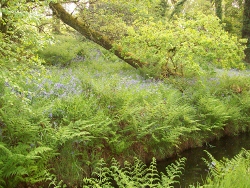
Bluebells and birds
Posted in General on Sunday 27th May 2012 at 6:33pm
The bluebells are carpeting the woodland floor but as a very amateur photographer I do not seem to be able to do justice to the magnificent display in the woodland – if you want to experience the wonderful colour and fragrance of the native bluebells on a warm sunny day you will have to visit us! The ferns are dominating the edge of the leat now having speedily unfurled their fronds over the last week and combined with the explosion of other foliage on the leat banks we are now seeing lots of insect life including damselflies with their electric blue bodies. Our lone cuckoo is still calling occasionally after it’s late arrival – first heard on April 30th ten days later than usual. Our other woodland birds are doing their best to make up for this by heralding the dawn very enthusiastically each day – we do not need an alarm clock!

Jobs for the spring
Posted in Farm on Wednesday 23rd May 2012 at 12:15pm
The timely arrival of the rain followed by some warmer weather has enabled our grass to get growing at a rate that allowed us to put all our cattle out onto the pastures. The cattle barns are being mucked out and the silage fields left un-grazed for the grass crop to grow on until there is enough tonnage of grass to cut it and turn it into our big bale silage – for next winters fed rations. It is clear that the cattle are contented now with the sun on their backs and the calves well fed, it’s time for a well earned rest. Corndon Tor makes a wonderful back drop! Some of the other jobs for the spring include, disbudding and castrating the calves, protecting the cows from flies with a pour-on fly repellent, clean out the cattle sheds and spread the dung, spot spray the injurious weeds e.g. docks, nettles, thistles and ragwort (this is part of the cross compliance rules we have to meet) and catch up on the paper work applying for cattle passports etc. One worrying job for this week is our cattle’s TB test.
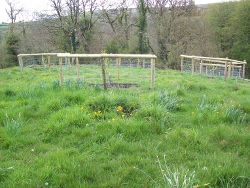
Orchard creation
Posted in Farm on Monday 7th May 2012 at 1:40pm
Under our Higher Level Stewardship on the farm we have planted a small new section of orchard which includes cider apple, plum and cherry trees. Our newly planted orchard is just showing signs that the trees have rooted in well with the cherry trees are already producing small leaves. The young apple trees have just been pruned to encourage them to bush out rather than shoot up, the stoned fruit trees will be pruned in the summer. All are now protected from our wild deer with suitable fencing around each tree, this also means we can graze the field around the new trees with our cattle and Dartmoor heritage ponies without worrying that the trees will be eaten!

Turbines fully open
Posted in Hydro on Wednesday 25th April 2012 at 6:18pm
We often loose out on one enterprise only to gain on another. The cows may still be in their winter housing but our hydro electric production has steadily risen to full power as the rain has continued to fall with surplus water tumbling over the weir and spillway at the intake. At the forebay I watch the screener being triggered regularly by the debris being carried in the storm water, and, as I sit at my computer writing this I spy the heron visiting in case he has the opportunity to take a fish or two. He leaves after a few minutes without his tea (our protection is obviously working) then I look up and see a majestic buzzard circling overhead. What an office to work from!

Contented mother and daughter
Posted in Farm on Wednesday 25th April 2012 at 6:16pm
Evidence of one of the pleasures of farming – seeing a new born calf, just 12 hours old, safely cuddled up to its mum. We are still calving our cows inside due to the ferocious weather we have had over the last few days. The older calves born in the early part of the month are now going out by day into a lush grass field to “kick up their heels”; their mum’s are enjoying the sweet new season’s grass too.

Hedgerows at Old Walls
Posted in General on Wednesday 11th April 2012 at 12:12pm
Farming at 1000ft (300m) our season is shorter than our lowland friends and while we still have a wonderful display of daffodils with more still to bloom, “down the hill” they are seeing these delightful flowers die back. Our hedgerows are just the same with the delicate blackthorn flowers on their bare branches only now showing their best against the vivid green of the hawthorn leaves. The remainder of the hedgerow is looking much as it has all winter.
Rain at last
Posted in Hydro on Tuesday 10th April 2012 at 5:15pm
With our “hydro” hats on we were very pleased to see the rains come over the Easter weekend. The West Webburn was running at a low summer flow level until yesterday. Although most of the rain has been taken up by the very dry soils (good for our farming!) there was some surplus that made its way to the rivers. For about 12 hours the river was running at normal winter flows rates. However, it has settled back now and is producing electricity at about 18% production, still way below where we would expect it to be but better than before Monday’s rain. It also brought another wave of smolts down stream and we again left our fish pipe open all night. This morning they have all moved on beyond us on their journey to the sea.
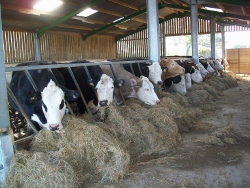
New life on the farm
Posted in Farm on Tuesday 10th April 2012 at 5:03pm
Despite the glorious weather we had through March we are still feeding our suckler cow’s winter rations. The grass has been slow to grow from lack of rain and warmth – although our days have been warm the nights have produced heavy frosts and have kept the soil temperature down. The cows have travelled back to the barns at Old Walls to be closer to home as they are due to calve through April and May. To date we have 4 new calves, all arrived without assistance and are doing well. With the change in the weather over the Easter weekend all the cattle were glad of some shelter from the howling winds and lashing rain.
Smolt migration
Posted in Hydro on Monday 26th March 2012 at 12:12pm
Yet more evidence that the weather is behaving in a very unseasonable way – the smolts are running. Over the weekend we noticed salmon smolts in our leat and by Sunday morning they were in the forebay. This is the earliest we have seen them “run to the sea” since we built the hydro scheme. Maybe the migration is due to the warm weather or perhaps the summer river levels? Whatever the reason we had the fish pipe open for 24 hours and they have all successfully continued their journey past us. Let’s hope in 2 or more years time they will be back in the rivers to spawn and start the species life cycle again.
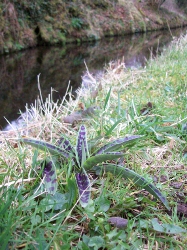
Spring has sprung!
Posted in General on Thursday 22nd March 2012 at 10:20am
Signs of spring are showing themselves everywhere but one of the plants I eagerly look for each year is the Early Purple Orchid with its distinctive spotted leaves. They are appearing along the leat side now.
The trees are slowly showing signs of the coming season too with buds just forming and catkins in abundance.
The dawn chorus is loud enough to be our alarm call at this time of year, the owls let us know they are busy too during the night and the wood pecker is very actively drilling into trees during the day - no doubt to find food or a suitable tree for nesting in.

January 2012 - New website launched
Posted in General on Monday 23rd January 2012 at 8:47am
We are pleased to announce the launch of our new website for 2012 and hope you like it. Please feel free to send us comments using our new enquiry form.
The new page about our farms contains information about Old Walls and Lowertown Farms and how they are run.
We also have an interactive map so you can zoom in and see exactly where we are and also get directions from your location.
The information about our site, free guided walks and talks and presentations has also been updated and expanded.